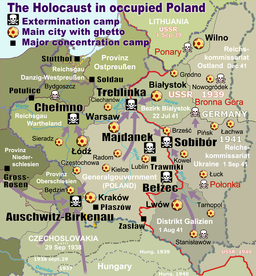Białystok Ghetto
| Białystok Ghetto | |
|---|---|

Liquidation of the Białystok Ghetto, August 15–20, 1943. Jewish men with their hands up, surrounded by German military unit
|
|
| Location | Białystok, German-occupied Poland |
| Date | July 26, 1941 – September 15, 1943 |
| Incident type | Imprisonment, mass shooting, forced labor, starvation, deportations to death camps |
| Perpetrators | Nazi SS, Orpo police battalions, Trawniki men |
| Białystok in World War II | |
|---|---|
| Białystok Ghetto location northeast of Treblinka in German-occupied Poland. Main ghettos marked with stars; death camps, with white-on-black skulls |
The Białystok Ghetto (Polish: getto w Białymstoku) was a World War II Jewish ghetto set up by Nazi Germany in the newly formed capital of Bezirk Bialystok district of German-occupied Poland between July 26 and early August 1941. About 50,000 Jews from the vicinity of Białystok and the surrounding region were herded into a small area of the city. The ghetto was split in two by the Biała River running through it (see map). Most inmates were put to work in the forced-labor enterprises for the German war effort, primarily in large textile, shoe and chemical factories established within its boundaries. The ghetto was liquidated in November 1943 after the Białystok Ghetto Uprising was crushed. All its inhabitants were either killed locally or transported in cattle trucks to the Majdanek and Treblinka extermination camps.
The city of Białystok was overrun by the Wehrmacht on September 15, 1939, and a week later ceded to the invading Red Army in accordance with the Nazi–Soviet demarcation treaty. On September 27, 1939, it was annexed by the Soviet Union following mock elections conducted in the atmosphere of utter terror. According to the terms of the German-Soviet Pact signed earlier in Moscow, Białystok remained in Soviet hands until June 1941, assigned to the Belorussian Soviet Socialist Republic. Thousands of Jews flocked to the city from German-occupied Poland. Mass deportations to Siberia by the NKVD followed.
...
Wikipedia

